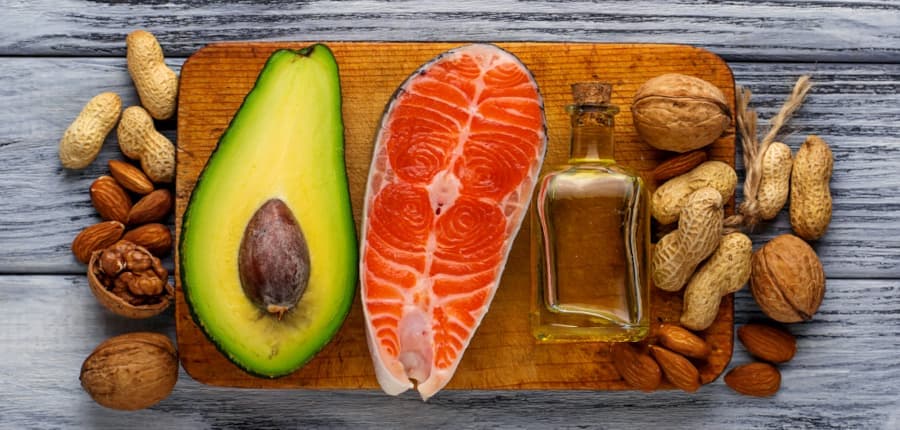Many athletes believe that fat intake is bad for them, as it is often associated with weight gain and decreased sports performance. However, fats play a crucial role in an athlete's diet. Several processes in your body depend on fats, and particularly in endurance sports, where intensity is lower, they contribute to optimising performance. The perception of fats among athletes is changing; this article explains what endurance athletes need to know about fats.
What are fats?
There are three macronutrients: carbohydrates, proteins, and fats. Carbohydrates and proteins provide around 4 kcal of energy per gram, whereas fats provide about 9 kcal per gram. Although fats contain more energy, their combustion is slower compared to carbohydrates. When the body needs quick energy during intense efforts, it prioritises carbohydrates. However, when the intensity of exercise is lower, fats become the ideal fuel source, allowing the body to preserve carbohydrate stores for a potential final sprint.
Besides providing energy, fats have other essential functions. Fat remains in the stomach for a relatively long time, contributing to prolonged satiety. Stored fat provides insulation and forms a protective layer around your organs. Cells require fats as building blocks. Additionally, vitamins A, D, E, and K are fat-soluble and are primarily obtained through dietary fats.
Good and bad fats
Fats can be classified as saturated or unsaturated. Unsaturated fats help lower cholesterol levels in your blood, reducing the risk of cardiovascular diseases. They also provide essential fatty acids that the body cannot produce, making it vital to obtain them through diet. It is important to balance fat intake across different types and avoid excessive consumption of any single type. Unsaturated fats are beneficial, but it is not just the fats themselves that matter—it is the type of food you consume that makes the difference.
It is essential to source daily fat intake from a variety of foods. This approach ensures that you consider not just fats but also other important nutrients found in those foods. Fats are present in meat, fish, poultry, dairy products, nuts, seeds, vegetable oils, and even some fruits and vegetables. These foods contain both unsaturated and saturated fats, along with other vital nutrients. Highly processed foods like biscuits and crisps contain high levels of saturated fat but lack beneficial nutrients.
The role of fats in an athlete's diet when losing weight
The amount of energy an athlete needs depends on their training. A periodised nutrition plan ensures that an athlete consumes the right nutrients to perform optimally. Therefore, expressing fat intake as a fixed percentage of total daily energy intake—such as 20% of total daily kilocalories—is challenging. Instead, athletes should prioritise carbohydrate and protein intake before determining the appropriate fat intake.
Athletes aim to optimise their body composition to generate as much power as possible per kilogram of body weight, with the goal of reducing fat mass. To lose weight, energy intake must be lower than energy expenditure. One of the most logical ways to achieve this is by reducing fat intake, as fats provide the highest energy per gram. Many athletes are already highly focused on minimising fat intake, but a certain daily fat intake remains essential.
Train low to improve fat oxidation during exercise
Fats are an important energy source during exercise. When exercise intensity is low, the body primarily burns fats. This fat oxidation is not related to body weight. For endurance athletes, optimising fat oxidation is crucial, as using fats helps preserve carbohydrate stores. Proper training can enhance fat oxidation by increasing the number of mitochondria and the enzymes involved in fat metabolism within muscles.
Nutrition also plays a key role in improving fat oxidation during exercise. Training with low muscle glycogen—low carbohydrate stores—is known as ‘train low’ and can enhance fat metabolism. There are several ways to implement this strategy. One common method is fasted training, where athletes perform a low-intensity session before breakfast.
The most effective way to apply ‘train low’ is by conducting two consecutive training sessions while restricting carbohydrate intake between them. The first session should be an intense workout when muscle glycogen levels are high. This depletes glycogen significantly. By limiting carbohydrate intake after this session, the second training session starts with low glycogen stores. The second session should then be performed at very low intensity, forcing the body to rely almost entirely on fat oxidation1.
For many athletes, incorporating such sessions into their training plan is challenging. The quality of ‘train low’ sessions is very low, as training at high intensity with depleted glycogen is nearly impossible. A personalised nutrition plan can help optimise dietary strategies.
A ‘Low carb, high fat diet’ does not work for endurance athletes
Because fat oxidation is essential for endurance athletes, and excessive sugar intake is frequently discussed, some consider adopting a low-carbohydrate, high-fat diet. Reducing carbohydrate intake and increasing healthy fats can enhance fat oxidation, but it also impairs carbohydrate metabolism in muscles. If exercise intensity remains below 70% of VO2max, this is not an issue. However, at higher intensities, the body depends on the much more efficient carbohydrate metabolism2.
1. Burke L. M. (2010). Fueling strategies to optimize performance: training high or training low?. Scandinavian journal of medicine & science in sports, 20 Suppl 2, 48–58. https://doi.org/10.1111/j.1600-0838.2010.01185.x
2. Burke, L. M., Ross, M. L., Garvican-Lewis, L. A., Welvaert, M., Heikura, I. A., Forbes, S. G., Mirtschin, J. G., Cato, L. E., Strobel, N., Sharma, A. P., & Hawley, J. A. (2017). Low carbohydrate, high fat diet impairs exercise economy and negates the performance benefit from intensified training in elite race walkers. The Journal of physiology, 595(9), 2785–2807. https://doi.org/10.1113/JP273230


